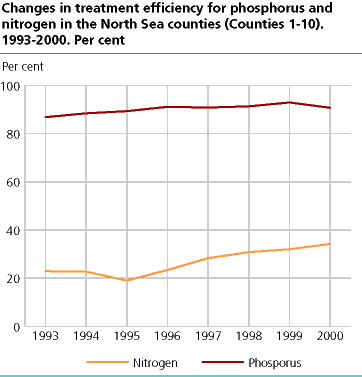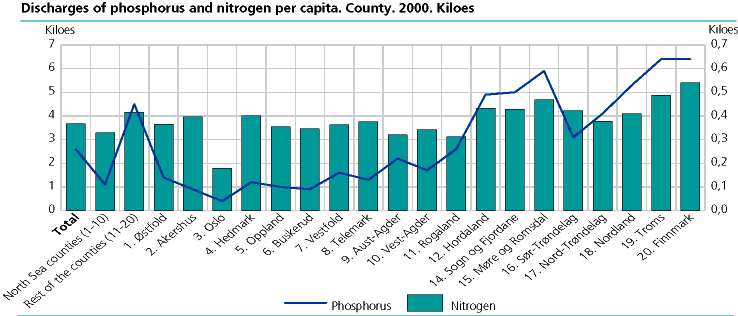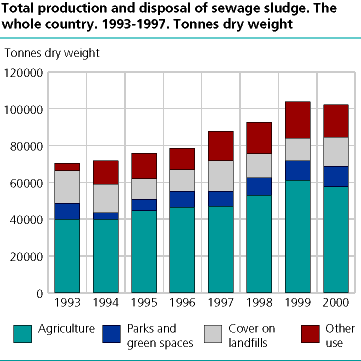Content
Published:
This is an archived release.
Increased nitrogen removals
The wastewater treatment efficiency for nitrogen removals has increased from 24 per cent in 1999 to 28 per cent in 2000, according to figures reported by the municipalities for the year 2000. Treatment efficiency is highest in the North Sea counties (34 per cent), but the largest increase in 2000 was experienced outside this area.
Highest removals of nitrogen in the Oslo region
53 per cent of the nitrogen was removed from the wastewater by the treatment plants in the Oslo region (Oslo and Akershus counties). In 1999 this figure was 44 per cent. It is expected that this efficiency rate will increase further by next year when another large treatment plant in Oslo will remove nitrogen more efficiently. In average every resident in Oslo discharged 1.8 kilo of nitrogen in 2000, while an average resident outside the North Sea counties discharged 4.2 kilos.
Minor decrease in phosphorus removals in the North Sea counties
The treatment efficiency for phosphorus in the North Sea counties decreased by 2.2 per cent from 1999 to 2000, but the overall treatment efficiency was still above 90 per cent. For the time being it its difficult to say if the decrease is due to abnormal situations in one or several of the treatment plants, or a result of errors in the figures reported. Outside the North Sea counties the treatment efficiency for phosphorus increased from 28 per cent in 1999 to 36.6 per cent in 2000. In average every inhabitant in the North Sea counties discharged 0.11 kilo phosphorus in 2000, while every resident in the other counties discharged 0.45 kilo.
Less heavy metal in the sewage sludge
The reported figures for 2000 show a decrease in the average contents of most heavy metal in sewage sludge. There are indications of a downwards trend with regards to discharge of copper, mercury and lead. The contents of other heavy metals have shown more year-to-year variations.
Disposal of the sewage sludge
A total of 102 000 tonnes of sewage sludge was disposed of the different purposes in 2000. This is a slight decrease from 1999, which can be explained by yearly variations in storage. 57 per cent of the sludge was used as fertilizer in agriculture, 11 per cent in parks and green spaces, 15 per cent as cover on landfills and 16 per cent for other purposes
|
Total discharges and treatment efficiency for different
types of wastewater treatment plants. 2000 |
| Total discharges | Average treatment efficiency1 | ||||||||||||||||||||||||||||||||||||||
|---|---|---|---|---|---|---|---|---|---|---|---|---|---|---|---|---|---|---|---|---|---|---|---|---|---|---|---|---|---|---|---|---|---|---|---|---|---|---|---|
| Phosphorus | Nitrogen | Phosphorus | Nitrogen | ||||||||||||||||||||||||||||||||||||
| Tonnes | Per cent | ||||||||||||||||||||||||||||||||||||||
| Total | 1 175,8 | 16 504,5 | 66,8 | 27,7 | |||||||||||||||||||||||||||||||||||
| Direct disharges | 197,8 | 1 478,0 | 0,3 | 0,2 | |||||||||||||||||||||||||||||||||||
| Mechanical | 481,6 | 3 823,8 | 30,3 | 24,9 | |||||||||||||||||||||||||||||||||||
| Chemical | 86,7 | 4 921,3 | 89,5 | 19,7 | |||||||||||||||||||||||||||||||||||
| Biological | 9,7 | 126,2 | 62,4 | 35,8 | |||||||||||||||||||||||||||||||||||
| Chemical/biological | 45,1 | 2 685,8 | 93,8 | 47,9 | |||||||||||||||||||||||||||||||||||
| Other treatment | 4,6 | 156,2 | 81,4 | 20,5 | |||||||||||||||||||||||||||||||||||
| Separate treatment | 350,4 | 3 313,1 | 32,8 | 15,3 | |||||||||||||||||||||||||||||||||||
| 1 | Seperate treatment is not included. |
| Content of heavy metals in sewage sludge. 2000. Milligrams per kilo dry weight |
| Average content | Maximum registered content | Limit value for agricultural areas | Limit value for parks etc. | Total amount in disposed of sewage sludge | Change in average content 1999-2000 | ||||||||||||||||||||||||||||||||||
|---|---|---|---|---|---|---|---|---|---|---|---|---|---|---|---|---|---|---|---|---|---|---|---|---|---|---|---|---|---|---|---|---|---|---|---|---|---|---|---|
| Milligrams per kilo dry weight | Kg | Per cent | |||||||||||||||||||||||||||||||||||||
| Cadmium (CD) | 1,0 | 19,0 | 2 | 5 | 105 | 7,0 | |||||||||||||||||||||||||||||||||
| Chromium (CR) | 24,8 | 2 190,0 | 100 | 150 | 2 535 | -16,6 | |||||||||||||||||||||||||||||||||
| Copper (CU) | 244,1 | 2 790,0 | 650 | 1 000 | 24 906 | -1,7 | |||||||||||||||||||||||||||||||||
| Mercury (HG) | 0,9 | 23,7 | 3 | 5 | 94 | -2,7 | |||||||||||||||||||||||||||||||||
| Nickel (NI) | 14,5 | 299,0 | 50 | 80 | 1 481 | 5,5 | |||||||||||||||||||||||||||||||||
| Lead (PB) | 20,6 | 224,0 | 80 | 200 | 2 099 | -14,9 | |||||||||||||||||||||||||||||||||
| Zinc (ZN) | 317,4 | 2 708,0 | 800 | 1 500 | 32 390 | -12,1 | |||||||||||||||||||||||||||||||||
Tables:
Contact
-
Gisle Berge
E-mail: gisle.berge@ssb.no
tel.: (+47) 48 12 19 97



